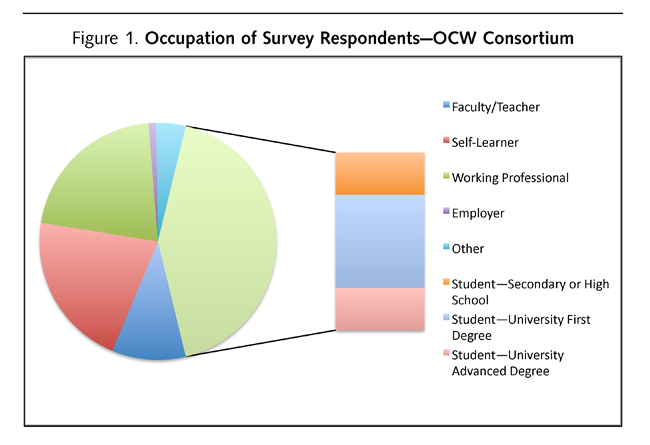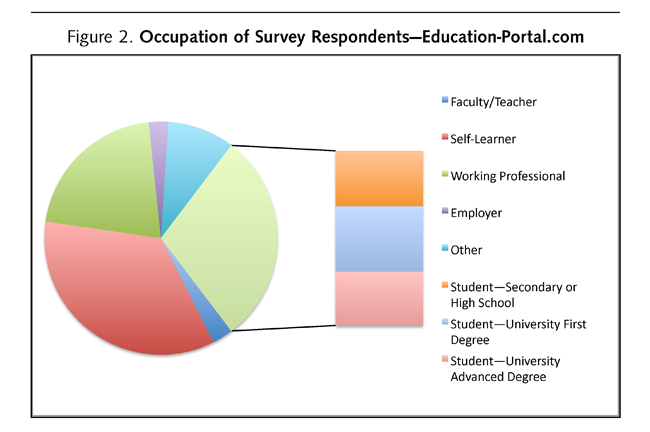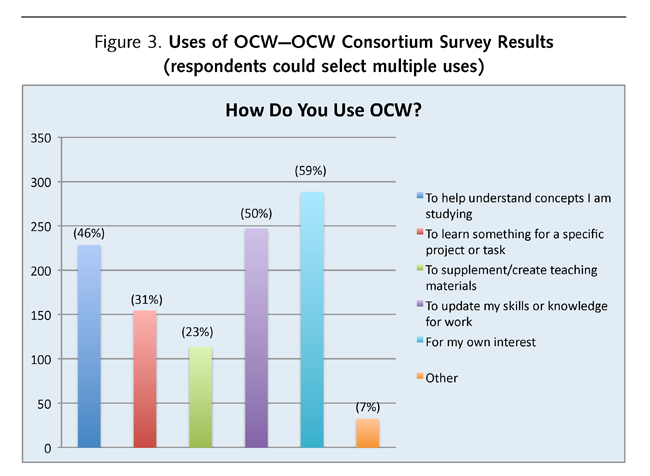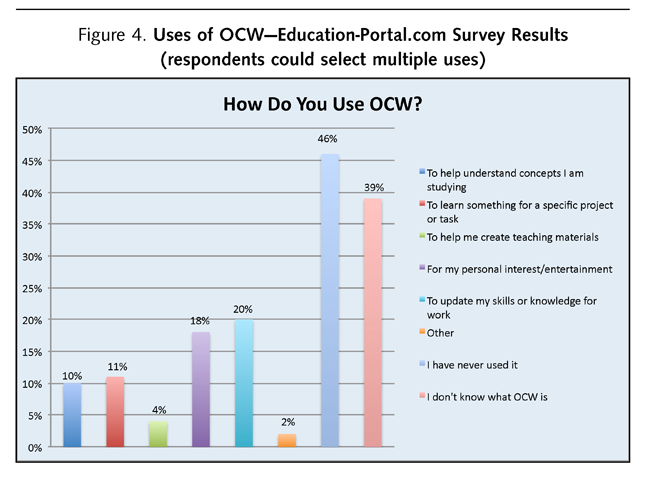Case Study 8: OpenCourseWare
- Published:
- Books and Monographs
- Author(s) and Contributors:
-
Author(s): Mary Lou Forward
- Source(s) and Collection(s):
-
Sources(s): EDUCAUSE Publications
- ParentTopics:
Abstract
A case study from Game Changers
Mary Lou Forward
 This chapter is licensed under a Creative Commons Attribution 3.0 Unported License
This chapter is licensed under a Creative Commons Attribution 3.0 Unported License
OpenCourseWare (OCW) and open educational resources (OER) are based on the simple yet powerful idea that free and open sharing in education can drive improvements in teaching and learning around the world. Sharing this common assumption, OCW, OER, and open education in general are proliferating.
Development of the OCW Movement
In 2000, when online distance-education programs were proliferating, a faculty committee at the Massachusetts Institute of Technology (MIT) recommended that MIT use the Internet not for paid educational programs, but to share all its classroom-based educational resources with the rest of the world for free, using an open license similar to that used by the open and free software movement. The scale of this institutional commitment—to openly share resources of its full curriculum—had never been made before.1
Other universities began to see the power of open sharing and began to share their own courses. To support this growing movement, the OCW Consortium was formed in 2005 (http://www.ocwconsortium.org). The consortium works to coordinate and support those who use, produce, and innovate with OCW and OER around the world.
OCW Users
Initially it was thought that OCW would primarily be a resource for faculty to exchange ideas and course materials. It quickly became apparent, however, that OCW supports formal and informal learning. Millions of people worldwide are now accessing high-quality educational materials for a variety of reasons, creating impacts well beyond the envisioned sharing of materials among faculty.
OCW content is freely and openly available and often hosted in multiple ways (on a university's OCW server, in repositories, through content providers, etc.). This presents challenges to collecting information about who is using OCW. Voluntary surveys of users are now being conducted more regularly by OCW projects. These survey results present interesting snapshots of the global audience for OCW and the ways it is being used. For example, surveys conducted in 2011 by the OCW Consortium and Education-Portal.com show that a significant percentage of users are not currently involved in formal education as faculty or students (see Figures 1 and 2).


An interesting difference in the audience for these surveys offers more information about general awareness of OER. The OCW Consortium site mainly attracts people who are looking for OER (see Figure 3), while the Education-Portal.com site attracts those who are looking for information on free courses. Responses on the use of OCW clearly show this difference, as a high percentage of respondents from the Education-Portal.com survey have never heard of OCW or have never used OCW (see Figure 4). Among those who have used OCW, more respondents said they use it to improve knowledge and skills for work than use it to help with formal studies. This could have interesting implications for workforce-development education.2


A survey of users of translated OCW materials by researchers at the University of Illinois at Urbana–Champaign revealed similar results. The Opensource Opencourseware Prototype System (http://www.myoops.org) has coordinated the translation of over 1,600 OCW courses into traditional and simplified Chinese. When asked to select all reasons for using these materials, 68.2 percent of respondents selected "to extend my professional knowledge," 62.8 percent selected "to increase knowledge of personal interests," 31.4 percent responded "to answer questions related to my profession," and 25.9 percent responded "for academic studies."3 Other surveys from OCW projects around the world show similar user profiles.4
Impact of OCW
OCW for Professional Development
In California, teachers of single subjects at the middle- and high-school levels are required to show competency either by completing an approved preparation program or by passing the appropriate single-subject California Subject Examination for Teachers (CSET). To assist practicing teachers in obtaining this credential, the University of California–Irvine (UCI) created preparation resources for CSET subject areas, available to anyone via its OCW site (http://ocw.uci.edu/collections/index.aspx). Beginning in October 2011, it offered teachers the opportunity to join a peer-run study group based on these materials.
Among the users of UCI's CSET preparation resources was Charles Reynes, an experienced educator seeking additional credentials. He said, "I am a 2007 California Teacher of the Year and a recipient of the 2008 Presidential Award for Excellence in Math and Science Teaching, yet I do not hold a degree in science. In order to supplement my multiple-subject credential with a Foundational Level Credential, I decided to take the CSET science tests, 118 and 119. This website was an invaluable study tool. I worked through every lesson and passed both exams on my first try. Anyone wishing to pass the CSET exam would do well to work through this fabulous online program."5
The African Virtual University (AVU) provided professional development through the creation and use of OCW. With the objective of developing a Pan-African teacher education program in mathematics, science, and ICT, AVU brought together 12 universities, 146 authors, and peer reviewers from 10 countries to develop curricula for bachelor of education programs in five subjects. Working in collaborative teams across institutions and languages, participants developed seventy-three modules, all of which are openly available in French, Portuguese, and English on AVU's portal (http://www.avu.org). AVU has recently received funding to develop more resources using this model. Through this strategy, AVU is using the collaborative development of OER to address identified needs and drive professional development for both the creators and users.
OCW for Educators
Educators use OCW to get materials and ideas for their teaching, as was originally envisioned. One example of this is James Wixson, an advisory engineer in systems engineering at the Idaho National Laboratories and affiliate instructor for the University of Idaho. In designing a new course on product development, he performed research that led him to MIT's OCW course 15.783J—Product Design and Development (http://ocw.mit.edu). Since the materials were openly licensed, Wixson used them as the basis for his course design, making modifications that reflected his own interests and background. The resulting new course was openly shared via Wixson's university web page.6
OCW has led to new collaborations among educators who previously were unknown to each other. Delft University of Technology (TU Delft) in the Netherlands has a very strong water management/water engineering program. OCW courses in the program include videos of lectures and written course materials (see http://ocw.tudelft.nl). Fundamental theories of water treatment are fixed, but examples of how these theories apply to different locations around the world can vary greatly. Faculty from the Institut Teknologi Bandung (Indonesia), Tshwane University of Technology (South Africa), and the National University of Singapore are partnering with water management faculty from TU Delft to adapt the OCW courses to their local situations. Taking the OCW video lectures and accompanying material as the basis for introducing theory, new examples from local waterways and water management needs are being incorporated to enrich the curriculum and make it relevant to different situations. These new examples allow students access to real, problem-based challenges that will broaden their understanding of the scope of water management globally. By sharing the common core of theoretical videos and materials, faculty are able to concentrate their teaching time on engaging students in problem solving and ensuring they have full understanding of concepts.7
Supporting Learning through OER
As the value of OER and OCW for both formal and nonformal learning became more apparent, developing support for learners was a logical next step. Several interesting models have emerged. Some, such as NIXTY (http://www.nixty.com), are built around a learning management system that functions similarly to platforms students use at many higher education institutions. Others, such as OpenStudy (http://openstudy.com), use a virtual-peer study-group model, organizing study groups around broad content areas or specific OCW courses. Learners can ask questions on the topic, either based on their own studies or on OCW materials, to which peers and volunteer mentors provide responses. Peer 2 Peer University (http://www.p2pu.org) has a learning platform based on peer support for learning, offering some courses that incorporate challenges and peer reviews as a means to build knowledge and skills. While individuals can propose courses or study groups, many universities are also using these and other platforms as a means to add value to their OCW materials for independent learners.
Learners are also organizing themselves. In China, several Internet portal companies have developed open education channels, providing OCW materials produced by Chinese universities, translating OER into Chinese, and captioning openly licensed videos with Chinese subtitles. One of the largest providers of open content in China, NetEase (http://open.163.com), has over five thousand videos available, with another nine hundred in production. Its open education channel attracts more than one million unique visitors daily. One user of NetEase's site began to microblog about the open videos she was viewing. Within six weeks, she had three thousand followers interacting on the content. They organized a series, continuously working on different videos, and she invited people to submit reflection papers based on their learning. She sent out small gifts to the authors of the papers she liked best. This spontaneous study group had no formal affiliation, was organized and run completely by the learners, and offered incentives at its own expense.8
Challenges
MIT first announced its OCW program in April 2001. The growth of OCW worldwide in the ten years since that announcement has been quite dramatic. While there have been many successes, there remain several important challenges. The first decade of OCW focused primarily on content creation by encouraging faculty and universities to share their educational materials with the world. A sufficient breadth and depth of materials were needed as building blocks for the improvements in teaching and learning that this sharing was expected to bring. Content creation was largely up to each contributor, with no master plan in place for soliciting contributions in particular areas.9 Intentional creation of OCW and OER to fill in the gaps is needed, which requires a thorough inventory of existing available resources. This in turn can lead to curricular pathways for learners, such as those laid out for students in formal education programs.10
The movement also faces challenges in helping users find and use appropriate material. OCW and OER are not categorized under a common subject-area classification protocol; rather, each author, producer, or collection of material classifies content independently. There is no single repository for OER—it is hosted on different platforms and by different services. This makes it difficult for teachers and learners to find OCW and OER through general search engines. People searching for OCW must have at least some idea of where to start looking in order to be successful. Making OER easier to find would result in its being more usable by more people.
Another important challenge to the movement is demonstrability of its impact. Since OCW can be accessed without a login on the majority of sites, it is very difficult to know who is using it and for what purpose. The reliance on the completion of voluntary surveys does not necessarily ensure a representative sample of users. Website analytics can provide an indication of numbers of visitors, time spent on websites, and geographic origin of hits, but do not give the full picture of impact. As more learner tools are developed that require logins for meaningful implementation (such as study groups), we may gain insight into the ways OCW and OER are supporting teaching and learning, which in turn can drive improvements to both tools and content.
Future Directions
Emerging projects have exciting implications for the future of OER and OCW. Several different organizations and projects are working on video capture, rapid transcription of videos, and improvements in automatic translation programs.11 Other projects, such as the Flexible Learning for Open Education project (http://floeproject.org), are focusing on ensuring that materials are accessible to people with disabilities and that they support learners with different learning preferences.
Awareness-raising campaigns, such as Open Education Week (http://www.openeducationweek.org), are striving to make more people aware of the resources available to help them reach their learning goals. With greater public awareness we can invite greater public participation, which will help shape the future of OCW and OER to maximize the effect that free and open sharing in education can have on supporting improvements in teaching and learning worldwide.
Notes
- For more information on the evolution of OCW at MIT, see Cecilia d'Oliveira, Steve Carson, Kate James, and Jeff Lazarus, "MIT OpenCourseWare: Unlocking Knowledge, Empowering Minds," Science 329, no. 5991 (July 30, 2010): 525–26, http://www.sciencemag.org/content/329/5991/525.full.
- OCW Consortium user survey results from April–September 2011, 512 respondents (survey results published in the OCW Consortium December 2011 newsletter and made available at http://www.ocwconsortium.org/en/community/documents/cat_view/54-ocwc-newsletters); Education-Portal.com survey conducted April–June 2011, 421 respondents (partial results from the Education-Portal.com survey were published on its blog at http://education-portal.com/articles/Understanding_OCW_A_Field_Guide_to_Free_Education.html).
- Wen-Hao David Huang and Wendi Shen, "Who Are Using Open Courseware and How Do They Use It? An Exploratory Case Study from a Chinese-Based Open Courseware Portal in Taiwan (OOPS)," available for download at http://www.ocwconsortium.org/en/community/documents/cat_view/102-ocwoer-research.
- For examples, see TU Delft's results at http://opencourseware.weblog.tudelft.nl/2011/09/09/tu-delft-opencourseware-user-survey, MIT's results at http://ocw.mit.edu/about/site-statistics/, and Fundação Getulio Vargas's results at http://www.slideshare.net/OCWConsortium/ocwc-fgv-onlinestavros05052011mit.
- Response to a user survey conducted by the OCW Consortium.
- Steve Carson, "Case_Study_112210_MIT OCW" (presentation shared with the author November 29, 2010).
- For more information, see the presentation "New Directions in Drinking Water Engineering Education" by Jasper Verberk, Peter de Moel, and Hans van Dijk at http://www.slideshare.net/OCWConsortium/new-directions-in-drinking-water-engineering-education.
- Presentation at the NetEase Open Education Channel international launch event, February 19, 2011. For an example of the microblog study group, see http://open.163.com.
- This is beginning to change with projects such as Washington State's Open Course Library, which solicited the creation and sharing of materials for the eighty-one highest-enrolled courses across the state stystem: http://www.opencourselibrary.org.
- The Saylor Foundation (http://www.saylor.org) is providing such pathways through free and open materials related to the top ten undergraduate majors in U.S. higher education.
- For examples, see the Opencast community (http://opencast.org), an interview with the Opencast Matterhorn Project product manager (http://videolectures.net/single_schulte_interview/), and the website http://videolectures.net, which provides videos from the Machine Learning Summer School.
Mary Lou Forward is the Executive Director of the OpenCourseWare Consortium. The OCW Consortium is dedicated to realizing the positive impacts of open sharing on teaching and learning globally, with membership of over 275 institutions and organizations from around the world.
 This chapter is licensed under a Creative Commons Attribution 3.0 Unported License
This chapter is licensed under a Creative Commons Attribution 3.0 Unported License
© 2012 Mary Lou Forward